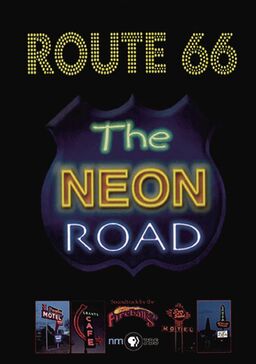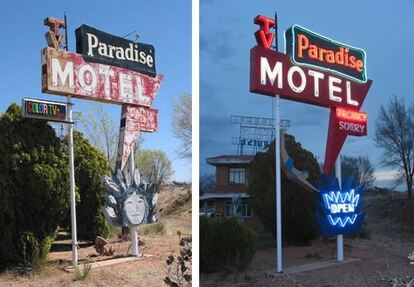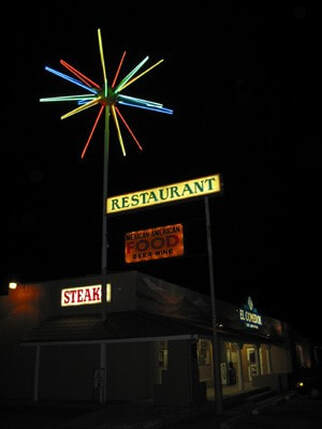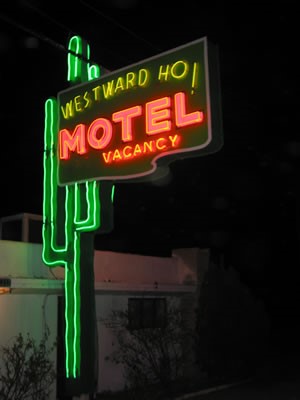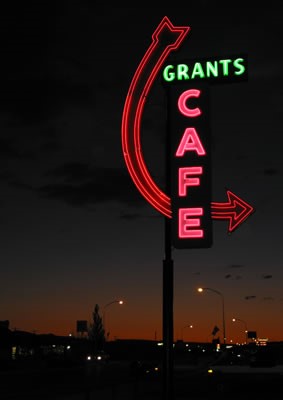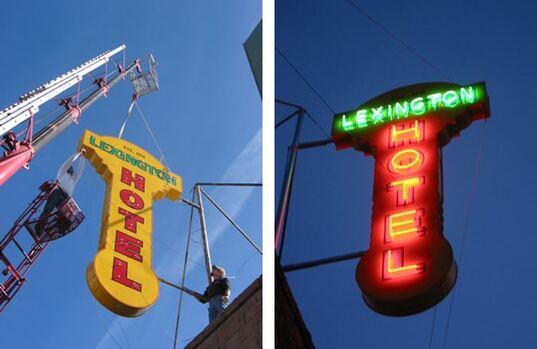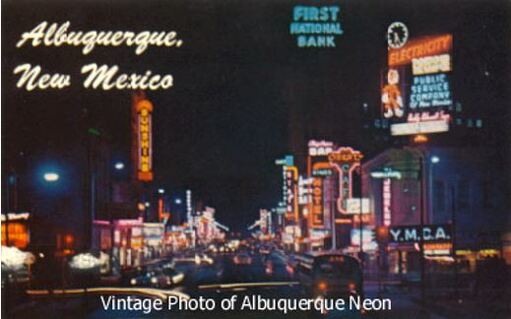
There are nine new reasons to rediscover Route 66 in New Mexico. In 2003, nine vintage Route 66 neon signs have been restored to their former brilliance. From the wonderful TeePee Curio Shop sign in Tucumcari, to the wild and crazy neon Rotosphere in Moriarty, to the elegant Lexington Hotel sign in Gallup, the beauty and artistry of classic neon is once again dazzling and delighting Route 66 enthusiasts.
There was a time when Mercury Meteors, Olds Rocket 88s, and the Pontiac Star Chiefs would trek through a galaxy of neon on Route 66. The streets with illuminated with a palette of ruby reds, sapphire blues, and emerald greens that broadcast promises of adventure, discovery, and gratification. Neon cowboys, Indians, sombreros, teepees, cactus, longhorn steers, thunderbirds, swallows, wiener dogs, ponies, and other critters and characters would come out at night to greet visitors. Places with neon lit names like the Bow and Arrow, the Royal Palacio, the Pig Stand, the Lariat, the Oasis, the Arrowhead, the Desert Sun, and the Trails West called out with invitations to stop and experience something unique.
Elmo Baca, the former New Mexico State Historic Preservation Officer, must have recalled the neon galaxy that was far-far-away in his memory and envisioned a project to rekindle appreciation of vintage neon and its importance to Route 66. In 1999, the Route 66 Corridor Preservation Act was passed by the U.S. Congress and money was designated for Route 66 preservation. The National Park Service was charged with administering the project and a Route 66 Corridor Preservation Office was established and led by Michael Romero Taylor. When the first request for proposals for Route 66 preservation projects was issued, Elmo came forward with his bold idea to restore neon signs. The project was funded and after a competitive bidding process, the New Mexico Route 66 Association was selected to execute the project.
Johnnie V, the New Mexico Route 66 Association President, volunteered to lead the project. In order to bring guidance, wisdom, and experience to the project, an all-star panel was assembled. The panel members were Dr. David Kammer, Don Usner, Steve Fitch, and Michael Wallis. David is a well-known historian in New Mexico who appeared in the PBS special Route 66 in New Mexico and has published studies of historic properties on Route 66. Steve Fitch is an accomplished neon tube bender, contributor to the book Vintage Neon, and author of several books including Diesels and Dinosaurs, a photo essay on roadside culture. Don Usner is a published author whose most recent work is New Mexico Route 66 on Tour - The Legendary Architecture from Glenrio to Gallup. Michael Wallis is the Pulitzer Prize nominated author, speaker, and champion for Route 66 and roadside culture. The panel was empowered to draw up evaluation criteria and select the projects for restoration.
At the conclusion of the process, the Association had 16 applications for restoration projects. At first, business owners were skeptical that there could be a government program that was intended to directly help mom & pop business owners. But after one-on-one discussions, it was accepted; the little guy had a chance!
Through a combination of business owner in-kind contributions, third party donations, donation of the project management fee by the Association, and contractor negotiations, nine signs were chosen for restoration with contracts awarded to five neon contractors.
After meeting all the participants in the project, it was realized that the project was worthy of a film documentary. The Association presented the opportunity to film the project to Michael Kamins, the Producer of the Rocky Mountain Emmy award-winning documentary "Route 66 in New Mexico." Michael agreed to a partnership to produce a 26-minute documentary, which aired on the local PBS show, "Colores." The DVD is available here in our online store. Please read on...
There was a time when Mercury Meteors, Olds Rocket 88s, and the Pontiac Star Chiefs would trek through a galaxy of neon on Route 66. The streets with illuminated with a palette of ruby reds, sapphire blues, and emerald greens that broadcast promises of adventure, discovery, and gratification. Neon cowboys, Indians, sombreros, teepees, cactus, longhorn steers, thunderbirds, swallows, wiener dogs, ponies, and other critters and characters would come out at night to greet visitors. Places with neon lit names like the Bow and Arrow, the Royal Palacio, the Pig Stand, the Lariat, the Oasis, the Arrowhead, the Desert Sun, and the Trails West called out with invitations to stop and experience something unique.
Elmo Baca, the former New Mexico State Historic Preservation Officer, must have recalled the neon galaxy that was far-far-away in his memory and envisioned a project to rekindle appreciation of vintage neon and its importance to Route 66. In 1999, the Route 66 Corridor Preservation Act was passed by the U.S. Congress and money was designated for Route 66 preservation. The National Park Service was charged with administering the project and a Route 66 Corridor Preservation Office was established and led by Michael Romero Taylor. When the first request for proposals for Route 66 preservation projects was issued, Elmo came forward with his bold idea to restore neon signs. The project was funded and after a competitive bidding process, the New Mexico Route 66 Association was selected to execute the project.
Johnnie V, the New Mexico Route 66 Association President, volunteered to lead the project. In order to bring guidance, wisdom, and experience to the project, an all-star panel was assembled. The panel members were Dr. David Kammer, Don Usner, Steve Fitch, and Michael Wallis. David is a well-known historian in New Mexico who appeared in the PBS special Route 66 in New Mexico and has published studies of historic properties on Route 66. Steve Fitch is an accomplished neon tube bender, contributor to the book Vintage Neon, and author of several books including Diesels and Dinosaurs, a photo essay on roadside culture. Don Usner is a published author whose most recent work is New Mexico Route 66 on Tour - The Legendary Architecture from Glenrio to Gallup. Michael Wallis is the Pulitzer Prize nominated author, speaker, and champion for Route 66 and roadside culture. The panel was empowered to draw up evaluation criteria and select the projects for restoration.
At the conclusion of the process, the Association had 16 applications for restoration projects. At first, business owners were skeptical that there could be a government program that was intended to directly help mom & pop business owners. But after one-on-one discussions, it was accepted; the little guy had a chance!
Through a combination of business owner in-kind contributions, third party donations, donation of the project management fee by the Association, and contractor negotiations, nine signs were chosen for restoration with contracts awarded to five neon contractors.
After meeting all the participants in the project, it was realized that the project was worthy of a film documentary. The Association presented the opportunity to film the project to Michael Kamins, the Producer of the Rocky Mountain Emmy award-winning documentary "Route 66 in New Mexico." Michael agreed to a partnership to produce a 26-minute documentary, which aired on the local PBS show, "Colores." The DVD is available here in our online store. Please read on...
Tucumcari Tonite!
Tucumcari has always had an outstanding array of vintage neon highlighted by the Blue Swallow Motel. But now, it's even better with three new restorations. The TeePee Curio Shop sign, an elaborate neon TeePee, has been restored based on vintage photographs and inspection of the sign. Mike Callens, the owner, did the preparation work. Mike erected scaffolding on the back of his pickup truck and spent several weeks painstakingly removing dead paint, applying primer, and painting details with great care and skill. The detail included individually painted cactus needles on the cactus arms. The neon restoration was completed by Clovis Sign Company. The location of the TeePee is within line-of-sight of the Blue Swallow Motel and the close proximity of these two properties creates an impressive streetscape.
Tucumcari has always had an outstanding array of vintage neon highlighted by the Blue Swallow Motel. But now, it's even better with three new restorations. The TeePee Curio Shop sign, an elaborate neon TeePee, has been restored based on vintage photographs and inspection of the sign. Mike Callens, the owner, did the preparation work. Mike erected scaffolding on the back of his pickup truck and spent several weeks painstakingly removing dead paint, applying primer, and painting details with great care and skill. The detail included individually painted cactus needles on the cactus arms. The neon restoration was completed by Clovis Sign Company. The location of the TeePee is within line-of-sight of the Blue Swallow Motel and the close proximity of these two properties creates an impressive streetscape.
Heading west toward the busiest intersection in town, you'll find the restored La Cita restaurant sign in front of the famous sombrero capped building. The restoration of the La Cita Restaurant was based on a vintage postcard. The restoration, including the motorized rotation of the sign and the rebuilding of the peripheral "chaser" lights, was performed by Clovis Sign Company.
At the far west end of town is the restored Paradise Motel sign, which presented the biggest surprise in the project. The unrestored sign included a lower section depicting portrait images of Tocom and Kari, characters from a tale of a tragic Indian couple from whom Tucumcari is said to have received its name. The project was bid as a restoration based on its existing Tocom-Kari features. However, subsequent research yielded an early photo on file at LaDeane Studios in Tucumcari.
The older photo revealed a very different sign that included a wonderful diving bathing beauty diving into a pool splash. After consulting with the Historic Preservation Division, it was decided that the restoration should include the original motif. At the same time, the creative use of the pool splash as a headdress for the Indian images and the quality of the images could be appreciated as folk art.
Therefore, the decision was made to allocate funding that would provide for the original restoration and also preserve the images of Tocom and Kari. The original "can" that included the two images was removed and installed on a pedestal in the vicinity of the sign while a new replica can is consistent with the restoration that was constructed. A remaining obstacle was the fact that the old sign displayed "POOL" in neon, yet the pool had been filled in and was no longer usable. It was decided to replace the word "POOL" with the word "OPEN" since the neon insulators supported four letters. In addition, it can be noted that both "POOL" and "OPEN" share two letters, "O" and "P." Close enough!
The older photo revealed a very different sign that included a wonderful diving bathing beauty diving into a pool splash. After consulting with the Historic Preservation Division, it was decided that the restoration should include the original motif. At the same time, the creative use of the pool splash as a headdress for the Indian images and the quality of the images could be appreciated as folk art.
Therefore, the decision was made to allocate funding that would provide for the original restoration and also preserve the images of Tocom and Kari. The original "can" that included the two images was removed and installed on a pedestal in the vicinity of the sign while a new replica can is consistent with the restoration that was constructed. A remaining obstacle was the fact that the old sign displayed "POOL" in neon, yet the pool had been filled in and was no longer usable. It was decided to replace the word "POOL" with the word "OPEN" since the neon insulators supported four letters. In addition, it can be noted that both "POOL" and "OPEN" share two letters, "O" and "P." Close enough!
Santa Rosa
The Sun-N-Sand sign stands tall in the middle of Santa Rosa. A vintage postcard of the Sun-N-Sand was located and provided a reference for the restoration. The sign features the Zia sun symbol with its characteristic round center with "sun rays" extending at the edges. Southwest Outdoor Electric of Albuquerque rebuilt the sign with neon work by A Brighter Image Neon of Albuquerque. Mike Minnear of Albuquerque was subcontracted to refurbish and repaint the sheet metal. Mike specializes in sign restoration and proudly says, "Check my business card, it's the only one you'll see in New Mexico that says,'sign restoration.'" Mike's attention to detail and extraordinary craftsmanship was admired by all that observed his work. Sitting in the Sun-N-Sand restaurant and enjoying the award-winning cherry dump cake, while admiring the classic Sun-N-Sand neon motel sign, that is a Route 66 experience.
The Sun-N-Sand sign stands tall in the middle of Santa Rosa. A vintage postcard of the Sun-N-Sand was located and provided a reference for the restoration. The sign features the Zia sun symbol with its characteristic round center with "sun rays" extending at the edges. Southwest Outdoor Electric of Albuquerque rebuilt the sign with neon work by A Brighter Image Neon of Albuquerque. Mike Minnear of Albuquerque was subcontracted to refurbish and repaint the sheet metal. Mike specializes in sign restoration and proudly says, "Check my business card, it's the only one you'll see in New Mexico that says,'sign restoration.'" Mike's attention to detail and extraordinary craftsmanship was admired by all that observed his work. Sitting in the Sun-N-Sand restaurant and enjoying the award-winning cherry dump cake, while admiring the classic Sun-N-Sand neon motel sign, that is a Route 66 experience.
Moriarty's UFO
Over at the El Comedor restaurant in Moriarty is where the project got wild and crazy with the restoration of Rube Goldberg type device called a rotosphere. When folks first encounter the rotosphere, it is hard not to say, "What in tarnation is that?" The rotosphere consists of two vertically counter-rotating spiked hemispheres with the entire unit rotating horizontally above a pole. The drive mechanism is an electric motor driven Ford Model A differential. The rotosphere was overhauled and refurbished by Soutwest Outdoor Electric of Albuquerque. The 8-foot long rainbow-colored spikes are individually outlined in neon by A Brighter Image Neon of Albuquerque. To see it in person is to witness an 18 foot diameter kaleidoscopic UFO. The El Comedor rotosphere is believed to be the only operational rotosphere along the length of Route 66. Bring a lawn chair and enjoy but be careful, you may get mesmerized.
Over at the El Comedor restaurant in Moriarty is where the project got wild and crazy with the restoration of Rube Goldberg type device called a rotosphere. When folks first encounter the rotosphere, it is hard not to say, "What in tarnation is that?" The rotosphere consists of two vertically counter-rotating spiked hemispheres with the entire unit rotating horizontally above a pole. The drive mechanism is an electric motor driven Ford Model A differential. The rotosphere was overhauled and refurbished by Soutwest Outdoor Electric of Albuquerque. The 8-foot long rainbow-colored spikes are individually outlined in neon by A Brighter Image Neon of Albuquerque. To see it in person is to witness an 18 foot diameter kaleidoscopic UFO. The El Comedor rotosphere is believed to be the only operational rotosphere along the length of Route 66. Bring a lawn chair and enjoy but be careful, you may get mesmerized.
Neon Cactus and the Aztec Arrow in Albuquerque
In Albuquerque, two classic motel signs were restored, the Aztec Motel and the Westward Ho Motel. Everybody loves the funky Aztec Motel with its amazing array of geegaws that have been attached like barnacles to the building. The Motel was built in 1931 and is on the National Register of Historic Places. The Aztec Motel sign is distinguished by the fact that the sign faces are colored porcelain enamel rather than painted steel. The porcelain was in fine condition with rich original colors enabling a relatively inexpensive restoration. Zeon Sign Company of Albuquerque originally designed and installed the sign and was the restoration contractor. The sweeping arrow on the Aztec sign flashes on and off in synchronization with the heartbeat of the old Route.
In Albuquerque, two classic motel signs were restored, the Aztec Motel and the Westward Ho Motel. Everybody loves the funky Aztec Motel with its amazing array of geegaws that have been attached like barnacles to the building. The Motel was built in 1931 and is on the National Register of Historic Places. The Aztec Motel sign is distinguished by the fact that the sign faces are colored porcelain enamel rather than painted steel. The porcelain was in fine condition with rich original colors enabling a relatively inexpensive restoration. Zeon Sign Company of Albuquerque originally designed and installed the sign and was the restoration contractor. The sweeping arrow on the Aztec sign flashes on and off in synchronization with the heartbeat of the old Route.
The Westward Ho Motel, built in 1948, is located on West Central in Albuquerque boasts a sign representing a saguaro cactus. The postcard image of the sign showed darker colors than the existing sign however the colors on the card appeared saturated and not realistic. The postcard appeared to show the neon cactus extending up into the face of the sign and intercepting the "MOTEL" letters and partially covering the neon "vacancy" wording. This appeared to be a liability in terms of readability and the apparently extended cactus neon was not restored to cover the face of the sign.
The sign was in good condition with the "MOTEL" neon operational. The owners of the Westward Ho refinished and repainted the sign. The neon glasswork and electrical work was performed by Brite-Lite Neon of Albuquerque. What would Route 66 be without a neon cactus?
The sign was in good condition with the "MOTEL" neon operational. The owners of the Westward Ho refinished and repainted the sign. The neon glasswork and electrical work was performed by Brite-Lite Neon of Albuquerque. What would Route 66 be without a neon cactus?
Extreme Restoration in Grants
The Grants Cafe sign represents an extreme in restoration challenges. The sign was blown down from its signpost several years ago as a result of gusty winds and was abandoned in a field several miles from its original location
The Association located three very different vintage images. Which configuration should we restore? The folks at the Historic Preservation Division advised that we should apply the "period of most significance" test. The 1950s configuration was chosen since it represented the version that existed while the Route 66 was a commissioned highway. The contractor for the sign restoration was SignArts of Albuquerque. SignArts determined that a competitor, Zeon Signs, had originally installed the sign and contacted Zeon to determine if old drawings and patterns existed. Zeon, a member of the restoration team as contractor on the Aztec Motel sign, was able to locate the original patterns as well as the original Work Order from 1958. The work order specifies the original neon colors and configuration. The restored sign is certainly a commanding and impressive sight on the Historic Route in a town without many other signature signs.
The Grants Cafe sign represents an extreme in restoration challenges. The sign was blown down from its signpost several years ago as a result of gusty winds and was abandoned in a field several miles from its original location
The Association located three very different vintage images. Which configuration should we restore? The folks at the Historic Preservation Division advised that we should apply the "period of most significance" test. The 1950s configuration was chosen since it represented the version that existed while the Route 66 was a commissioned highway. The contractor for the sign restoration was SignArts of Albuquerque. SignArts determined that a competitor, Zeon Signs, had originally installed the sign and contacted Zeon to determine if old drawings and patterns existed. Zeon, a member of the restoration team as contractor on the Aztec Motel sign, was able to locate the original patterns as well as the original Work Order from 1958. The work order specifies the original neon colors and configuration. The restored sign is certainly a commanding and impressive sight on the Historic Route in a town without many other signature signs.
Elegance in Gallup
The Lexington Hotel Sign is a roof-mounted sign located in the downtown area on Route 66 in Gallup. Although historical sources were consulted, no vintage photos of this sign were located. However, the sign finish and much of the original tubing remained to allow a faithful restoration. The restoration was performed as an in-shop job by Hinkley Signs of Gallup. The presence of peeling paint indicated that a complete stripping was required in order to apply a primer basecoat that would prevent future peeling. Restoration consisted of stripping, rewiring, reprimering, and repainting with a sprayed acrylic automotive style paint. The sign profile is sculptural and evocative of styles of the 1930s. The prominent location of this sign adds to the historic character of the building and adds jazz to the downtown streetscape.
The Lexington Hotel Sign is a roof-mounted sign located in the downtown area on Route 66 in Gallup. Although historical sources were consulted, no vintage photos of this sign were located. However, the sign finish and much of the original tubing remained to allow a faithful restoration. The restoration was performed as an in-shop job by Hinkley Signs of Gallup. The presence of peeling paint indicated that a complete stripping was required in order to apply a primer basecoat that would prevent future peeling. Restoration consisted of stripping, rewiring, reprimering, and repainting with a sprayed acrylic automotive style paint. The sign profile is sculptural and evocative of styles of the 1930s. The prominent location of this sign adds to the historic character of the building and adds jazz to the downtown streetscape.
Follow-up Project
During the application process for the neon sign project, a number of applications were received requesting assistance to restore architectural/ornamental neon. An example of this type of neon is the neon tubes used to line motel roof eaves. A review of vintage postcards revealed that architectural neon was integral to many historic Route 66 properties. However, the existing project did not provide for the restoration of architectural neon. Subsequently, a grant application was submitted by the New Mexico Route 66 Association that was funded for the year 2003 by the National Park Service Route 66 Corridor Preservation Office. It is expected that the restored architectural neon will further enhance the nighttime streetscapes in New Mexico's Route 66 communities.
During the application process for the neon sign project, a number of applications were received requesting assistance to restore architectural/ornamental neon. An example of this type of neon is the neon tubes used to line motel roof eaves. A review of vintage postcards revealed that architectural neon was integral to many historic Route 66 properties. However, the existing project did not provide for the restoration of architectural neon. Subsequently, a grant application was submitted by the New Mexico Route 66 Association that was funded for the year 2003 by the National Park Service Route 66 Corridor Preservation Office. It is expected that the restored architectural neon will further enhance the nighttime streetscapes in New Mexico's Route 66 communities.
The Pride is Back
The restoration of these classic Route 66 signs has resulted in renewed pride in ownership among business owners whose signs have been restored. In addition, the restoration of prominent classic neon signs has renewed community pride. Sign companies who practice neon sign-making have a renewed pride in their contribution to the cultural and historical value of Route 66.
Parallel with the neon restoration project, the New Mexico Heritage Preservation Alliance has published two documents with funding from the Route 66 Corridor Preservation Office. The first is a brochure titled, "Saving New Mexico's Route 66 Historic Signs" along with a "Model Sign Ordinance" that encourages preservation of historic signs and the use of new artistic neon signs that enhance streetscapes. Call the Alliance at 505-989-7745 for information.
Although photos communicate the beauty of classic neon signs, the signs really can't be fully appreciated except in person. These signs come alive at night, flashing, spinning, rotating and whirling. It has the feeling of a close encounter of the third kind. You are out there at night, brightly colored lights flash in the sky, and you hear the buzz of the high voltage transformers. A galaxy of neon awaits you, see for yourself!
Restorations are a joint project of the New Mexico Route 66 Association, the New Mexico Historic Preservation Division, and the National Park Service Route 66 Corridor Preservation Office. All photos by Johnnie V except the TeePee by Mike Callens. Copyright 2003. Permission required for republication.
The restoration of these classic Route 66 signs has resulted in renewed pride in ownership among business owners whose signs have been restored. In addition, the restoration of prominent classic neon signs has renewed community pride. Sign companies who practice neon sign-making have a renewed pride in their contribution to the cultural and historical value of Route 66.
Parallel with the neon restoration project, the New Mexico Heritage Preservation Alliance has published two documents with funding from the Route 66 Corridor Preservation Office. The first is a brochure titled, "Saving New Mexico's Route 66 Historic Signs" along with a "Model Sign Ordinance" that encourages preservation of historic signs and the use of new artistic neon signs that enhance streetscapes. Call the Alliance at 505-989-7745 for information.
Although photos communicate the beauty of classic neon signs, the signs really can't be fully appreciated except in person. These signs come alive at night, flashing, spinning, rotating and whirling. It has the feeling of a close encounter of the third kind. You are out there at night, brightly colored lights flash in the sky, and you hear the buzz of the high voltage transformers. A galaxy of neon awaits you, see for yourself!
Restorations are a joint project of the New Mexico Route 66 Association, the New Mexico Historic Preservation Division, and the National Park Service Route 66 Corridor Preservation Office. All photos by Johnnie V except the TeePee by Mike Callens. Copyright 2003. Permission required for republication.
